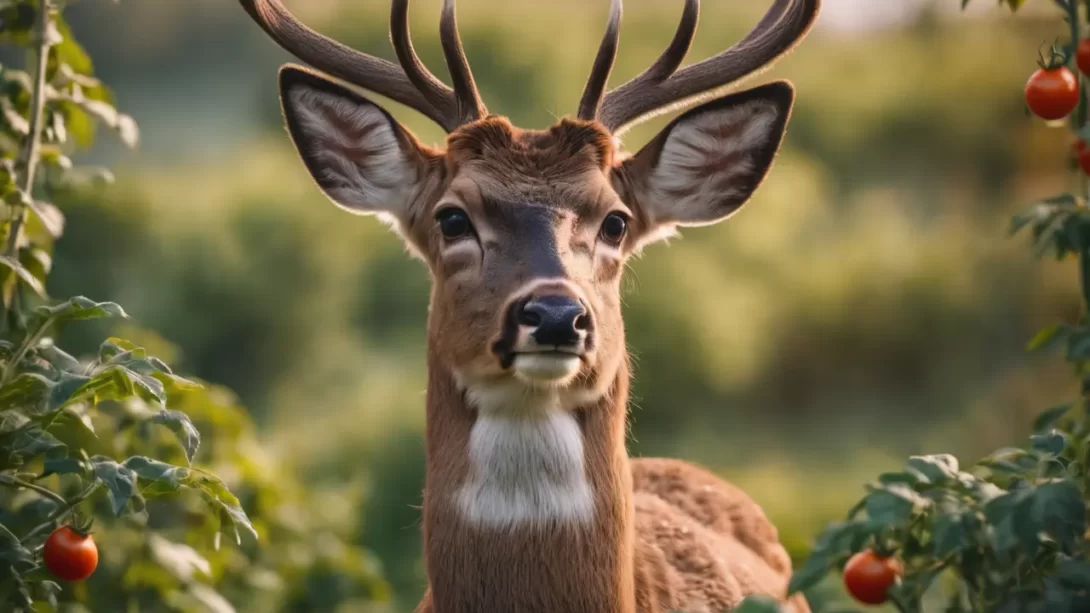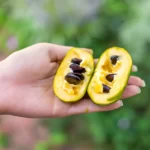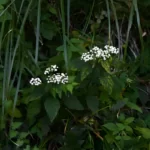Deer encroaching on vegetable gardens is a common challenge for many gardeners. Understanding how deer interact with specific plants, particularly tomatoes, is crucial for effective garden management. In this article, we explore deer behavior and dietary habits, focusing on their potential impact on tomato plants. This knowledge is essential for gardeners seeking to protect their crops while coexisting with local wildlife.
Deer Dietary Preferences
Deer are known for their adaptable and varied diet, which can cause problems for gardeners. Typically, these animals feed on a mixture of grasses, leaves, fruits, and nuts. However, when their natural food sources are scarce, deer often turn to gardens as an alternative source of sustenance.
The diet of deer changes with the seasons. In spring and summer, they are particularly drawn to young, tender plants, which can include the leaves and stems of tomato plants. During the fall, deer’s diet shifts towards more woody plant material, but they may still forage in gardens if other food sources are lacking. Understanding these seasonal dietary shifts is key to anticipating and mitigating the risk of deer eating your tomatoes.
The Attraction of Tomatoes to Deer
Tomato plants (Solanum lycopersicum) are a favorite among gardeners, cherished for their delicious fruits. But what about deer? Do these garden visitors share our fondness for tomatoes? The answer varies. While deer will eat almost anything when food is scarce, tomatoes are not usually their first choice. However, they might nibble on the leaves, stems, and even the fruits of tomato plants if other preferred food sources are not available.
Gardeners’ experiences with deer and tomato plants can differ widely. In some areas, deer may frequently visit gardens to eat tomatoes, while in others, these plants might be left untouched. Factors such as local deer population density, the availability of other food sources, and even individual deer taste preferences can influence their interest in tomato plants. This variability makes it important to observe local wildlife patterns and seek advice from fellow gardeners and wildlife experts in your area.
Factors That Draw Deer to Tomato Gardens
Several factors can increase the likelihood of deer visiting your garden and feasting on your tomato plants. The location of your garden plays a significant role. Gardens adjacent to woods or natural deer habitats are more prone to visits. Gardens that are easily accessible or lie along natural deer paths may also face more frequent deer incursions.
The stage of growth and health of tomato plants are also crucial factors. Lush, well-maintained tomato plants with abundant fruits are more attractive to deer. Young, tender plants are especially vulnerable, as they offer the soft, nutritious foliage that deer prefer. Additionally, the presence of ripe tomatoes can tempt deer, making mature plants at risk during the fruiting season.
Surrounding vegetation and alternative food sources in your garden and its vicinity can influence deer behavior. A diverse garden with a mix of plants, some of which are less appealing to deer, can reduce the risk of them targeting your tomatoes. On the other hand, a garden that is the only lush area in an otherwise food-scarce environment can become a prime target for hungry deer.
Effective Strategies for Protecting Tomatoes from Deer
Protecting tomato plants from deer requires a combination of tactics. One of the most effective methods is erecting physical barriers. Fencing is a popular choice; however, it needs to be sufficiently tall (at least 8 feet) and sturdy to prevent deer from jumping over or pushing through it. The type of fencing can vary from simple wire fences to more elaborate wooden structures, depending on your garden’s needs and aesthetic.
Another common strategy is the use of deer repellents. These can be commercially produced or homemade mixtures. Ingredients like garlic, soap, and hot peppers are often used in homemade repellents. The key to success with repellents is consistency in application, especially after rain, as well as rotating different types of repellents to prevent deer from becoming accustomed to them.
Introducing deer-resistant companion plants around your tomato garden is a natural way to deter deer. While no plant is completely deer-proof, certain species are known to be less attractive to deer. Examples include aromatic herbs like lavender and sage or plants with strong flavors or textures like marigolds and snapdragons. These plants can create an uninviting environment for deer while adding diversity and beauty to your garden.
Alternative Methods to Discourage Deer
In addition to physical barriers and repellents, there are other innovative ways to deter deer from your tomato garden. Implementing physical deterrents such as garden netting can provide a protective cover over your plants, keeping deer at bay while still allowing sunlight and water to reach the tomatoes. Scare tactics, including motion-activated sprinklers or hanging reflective items that move in the wind, can also be effective in startling and deterring deer from venturing too close.
Behavioral deterrents involve creating an environment that is less inviting to deer. Regular human activity in the garden, the use of noise-making devices, or installing lighting, especially motion-activated, can make the area less appealing to these nocturnal visitors. It’s important to note that deer can eventually become accustomed to these deterrents, so varying the methods or changing them periodically can enhance their effectiveness.
Community approaches can also play a significant role in managing deer incursions. Collaborating with neighbors to implement consistent deer-deterrent strategies across multiple gardens can create a more extensive barrier against deer. Additionally, understanding and participating in local wildlife management practices can contribute to a larger solution, balancing the needs of the local ecosystem with those of residential areas.
Conclusion
While deer may not always prefer tomatoes, they will eat them, particularly when their favored food sources are scarce. Understanding deer behavior and employing a combination of protective strategies can greatly reduce the risk of deer feasting on your tomato plants. From erecting physical barriers like fencing to using repellents and planting deer-resistant companions, there are many effective ways to safeguard your garden.
Gardening in areas frequented by deer requires a balanced approach, where the goal is not to eliminate wildlife but to coexist with it while protecting your crops. By employing diverse and adaptive strategies, you can enjoy a thriving tomato garden and a harmonious relationship with the local deer population. Remember, flexibility and observation are key to finding the right solution for your specific garden situation.



